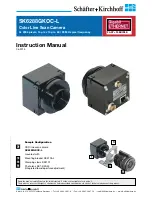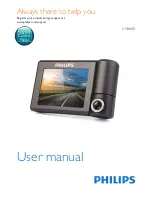
Spyder3 SC-34 Color Camera User's Manual
73
Teledyne DALSA
03-032-20116-01
Appendix D
Electrostatic Discharge and the CCD Sensor
Cam eras contain charge-cou p led d evice (CCD) im age sensors, w hich are m etal oxid e sem icond u ctor
(MOS) d evices and are su scep tible to d am age from electrostatic d ischarge (ESD).
Electrostatic charge introd u ced to the sensor w ind ow su rface can ind u ce charge bu ild u p on the u nd ersid e
of the w ind ow that cannot be read ily d issip ated by the d ry nitrogen gas in the sensor p ackage cavity.
When charge bu ild u p occu rs, su rface-gated p hotod iod es (SGPDs) m ay exhibit higher im age lag. Som e
SGPD sensors, su ch as the IL-P4 and the IT-P4 u sed in the DALSA‘s cam eras, m ay also exhibit a highly
non-u niform resp onse w hen affected by charge bu ild u p , w ith som e p ixels d isp laying a m u ch higher
resp onse w hen the sensor is exp osed to u niform illu m ination. The charge norm ally d issip ates w ithin 24
hou rs and the sensor retu rns to nor m al op eration.
WARN IN G:
Charge build up will affect the camera‘s flat-field correction calibration. To avoid an
erroneou s calibration, ensu re that you p erform flat-field correction only after a charge bu ild u p has
d issip ated over 24 hou rs.
Protecting Against Dust, Oil and Scratches
The CCD w ind ow is p art of the op tical p ath and shou ld be hand led like other op tical com p onents, w ith
extrem e care.
Du st can obscu re p ixels, p rod u cing d ark p atches on the sensor resp onse. Du st is m ost visible w hen the
illu m ination is collim ated . The d ark p atches shift p osition as the angle of illu m ination changes. Du st is
norm ally not visible w hen the sensor is p ositioned at the exit p ort of an integrating sp here, w h ere the
illu m ination is d iffu se.
Du st can norm ally be rem oved by blow ing the w ind ow su rface u sing a com p ressed air blow er, u nless the
d u st p articles are being held by an electrostatic charge, in w hich case either an ionized air blow er or w et
cleaning is necessary.
Oil is u su ally introd u ced d u ring hand ling. Tou ching the su rface of the w ind ow barehand ed w ill leave
oily resid u es. Using ru bber fingercots and ru bber gloves can p revent oil contam ination. H ow ever, the
friction betw een the ru bber and the w ind ow m ay p rod u ce electrostatic charge that m ay d am age the
sensor. To avoid ESD d am age and to avoid introd u cing oily resid u es, only hold the sensor from the ed ges
of the ceram ic p ackage and avoid tou ching the sensor p ins and the w ind ow .
Scratches can be cau sed by im p rop er hand ling, cleaning or storage of the sensor. Vacu u m p icking tools
shou ld not com e in contact w ith the w ind ow su rface. CCDs shou ld not be stored in containers w here they
are not p rop erly secu red and can slid e against the container.
Scratches d iffract incid ent illu m ination. When exp osed to u niform illu m ination, a sensor w ith a scratched
w ind ow w ill norm ally have brighter p ixels ad jacent to d arker p ixels. The location of these p ixels changes
w ith the angle of illu m ination.
Cleaning the Sensor Window
1.
Use com p ressed air to blow off loose p articles. This step alone is u su ally su fficient to clean the
sensor w ind ow .
All manuals and user guides at all-guides.com






































